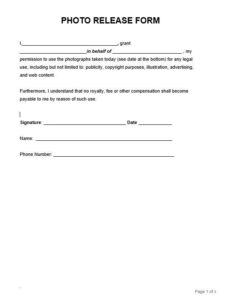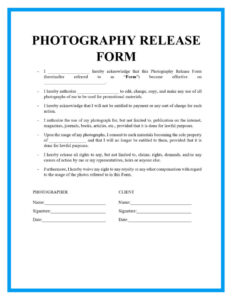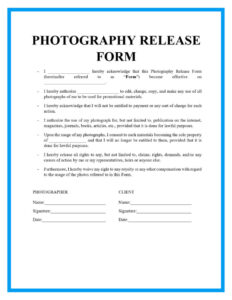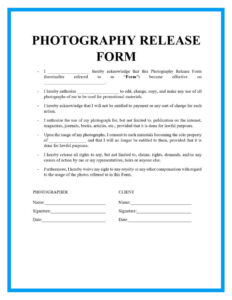Utilizing such a document offers several advantages. It protects organizations from potential copyright infringement claims and ensures legal compliance. For individuals, it provides transparency and control over how their image is used. This clarity fosters trust between parties and facilitates smooth collaborations in photography-related projects, from commercial shoots to event documentation. Standardized forms also simplify administrative processes, saving time and resources for everyone involved.
This foundational understanding of these agreements allows for a deeper exploration of specific applications and legal considerations related to image rights and usage. Topics such as model releases, commercial photography agreements, and the implications of social media sharing will be further examined.
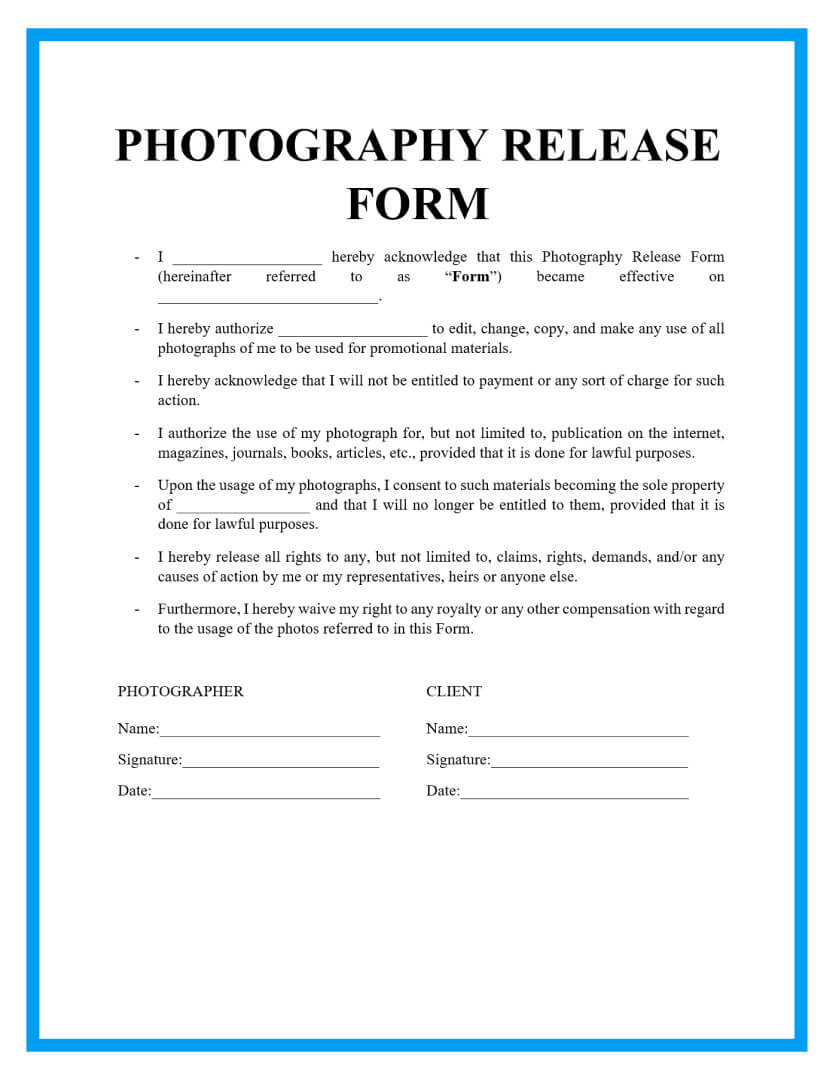
Key Components of a Photographic Release Form
Essential elements ensure a comprehensive and legally sound agreement regarding image usage rights. These components clarify expectations and protect all parties involved.
1. Identification of Parties: Clear identification of the individual being photographed (the subject) and the individual or organization granted usage rights is paramount. Full legal names and contact information should be included.
2. Scope of Usage Rights: The document must explicitly define the permitted uses of the photographs. This includes specifying media (print, online, etc.), distribution channels, and any geographical restrictions.
3. Duration of Consent: The timeframe for which the granted rights are valid needs clear definition. This can be a specific period or perpetuity.
4. Model Release (if applicable): If the photographs are to be used for commercial purposes, a specific model release clause is required, outlining any compensation and usage restrictions related to advertising or endorsements.
5. Liability Release: A clause releasing the photographer or organization from liability for any unintended consequences arising from the photograph’s usage is often included.
6. Revocation Clause: The agreement should specify under what conditions, if any, the subject can revoke consent and how that process should be handled.
7. Governing Law: The legal jurisdiction governing the agreement should be clearly stated to ensure consistent interpretation and enforcement.
8. Signatures and Date: The document must be signed and dated by both parties to signify agreement and acceptance of the terms. Witness signatures may also be required depending on local regulations.
Careful consideration of these components ensures a robust agreement protecting the interests of all stakeholders involved in the creation and use of photographic images. These provisions establish a clear framework for usage rights, minimizing potential disputes and fostering a professional and ethical approach to image licensing.
How to Create a Photographic Release Form
Creating a robust photographic release form requires careful attention to key legal and ethical considerations. A well-drafted document protects all parties involved and ensures clarity regarding image usage rights.
1. Define the Purpose: Clearly establish the intended use of the photographs. This determines the specific clauses and scope of the agreement.
2. Identify the Parties: Include complete legal names and contact information for both the subject(s) and the individual/organization obtaining usage rights.
3. Specify Usage Rights: Detail the permitted uses, including media types, distribution channels, and any geographical or temporal limitations.
4. Address Commercial Use: If applicable, incorporate a model release clause outlining compensation, usage restrictions, and any exclusivity agreements.
5. Include a Liability Release: This clause protects the photographer/organization from liability for unintended consequences arising from image usage.
6. Outline Revocation Procedures: Specify conditions for revoking consent and the process involved.
7. Specify Governing Law: State the legal jurisdiction that governs the agreement for consistent interpretation.
8. Obtain Signatures and Date: Ensure the document is signed and dated by all parties involved. Witness signatures may be required depending on local regulations.
9. Review and Update: Periodically review and update the template to reflect changes in legal requirements or industry best practices.
A comprehensive photographic release form safeguards the interests of all stakeholders, facilitating a professional and legally sound approach to image licensing. Meticulous drafting and clear communication ensure a smooth and ethical process for all parties involved.
Careful consideration of a photographic release form template is essential for anyone involved in capturing or utilizing photographic images. Understanding the key components, including clear identification of parties, comprehensive scope of usage rights, and provisions for consent revocation, ensures a legally sound and ethically responsible approach. Utilizing a well-drafted template safeguards the rights of both subjects and image users, mitigating potential disputes and fostering professional collaborations. Proper implementation of these agreements ultimately contributes to a more transparent and respectful environment within the photographic community.
The increasing prevalence of photography in various contexts underscores the importance of proactively addressing image rights. Developing standardized procedures for obtaining and managing image usage permissions is crucial for navigating the evolving legal landscape. This proactive approach protects individuals’ privacy while enabling the responsible and ethical use of photographic content across diverse platforms and purposes. Continued education and adaptation to emerging best practices will remain essential for fostering a sustainable and respectful photographic ecosystem.
